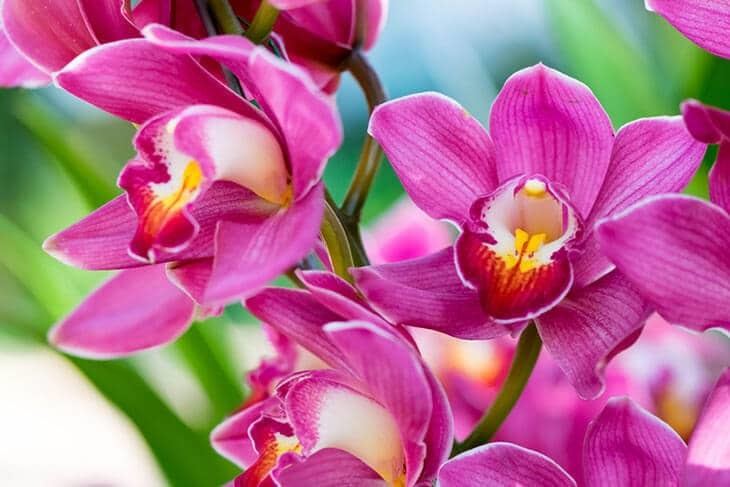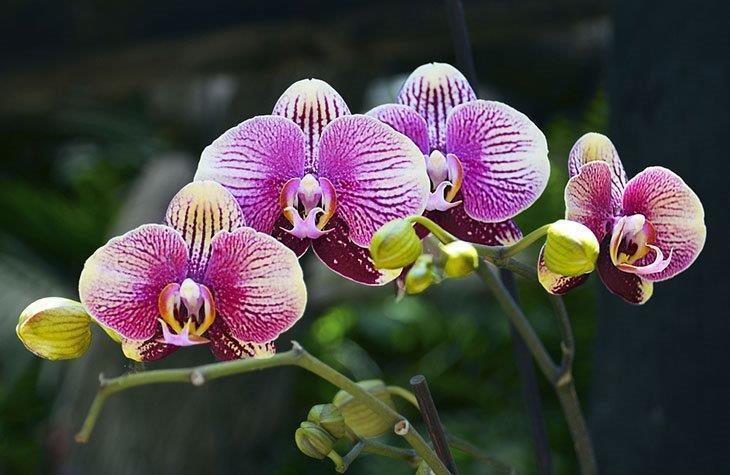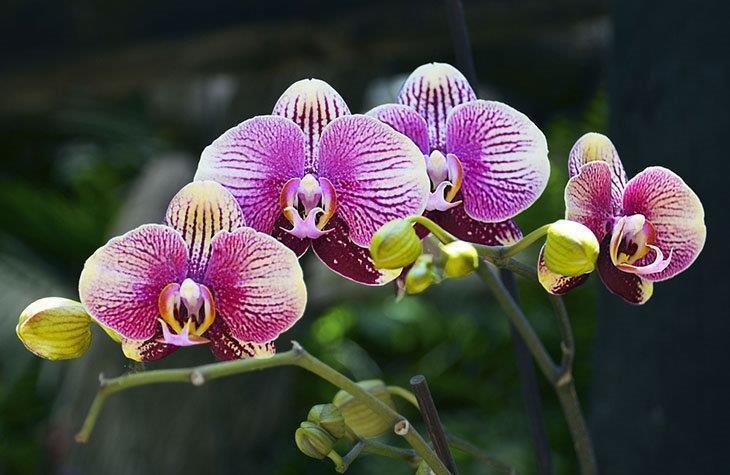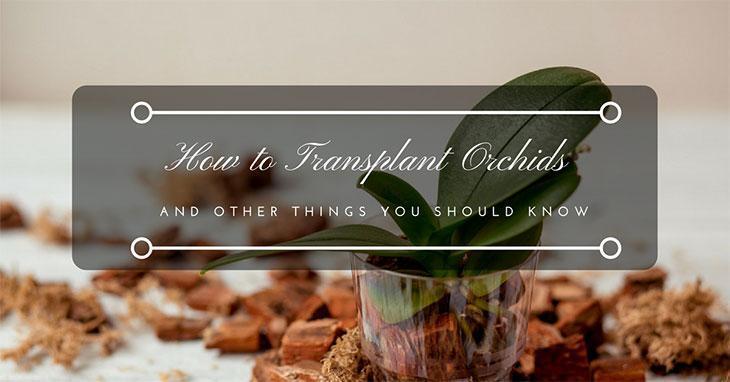Did you know that the presence of plants can have a calming effect on our surroundings? Decorating your home with orchids, in particular, not only helps you relax and reduce stress but also improves your mood and can even lower the risk of some cardiovascular diseases and other chronic illnesses. To make sure you get the most out of your orchid plants, you should also know how to transplant orchids. Furthermore, orchids increase the environment's humidity content, which is a good sign in avoiding seasonal illnesses such as coughs, dry skin, and sore throats.
It's no coincidence that orchids are one of the most popular gifts to give to friends or hospital visitors. Research suggests that a higher humidity level can decrease the likelihood of spreading the flu. So, giving an orchid doesn't just bring happiness to the recipient; it's also beneficial to their health. Plus, a beautiful orchid plant can brighten up a dreary hospital room, making everyone inside feel better.
Orchid plants may look stunning and provide glamorous blooms. However, many people underestimate them because they only know a few things about orchid care. Let me tell you a secret. Did you know that orchids are very important to the Chinese? Yes, they are! According to Feng Shui, orchids are known as the "King of Fragrant Plants," which means they represent fertility.
That's why orchids should be given extra care. For them to remain healthy, they must be transplanted periodically. This provides the plant with a fresh orchid potting mix as the old mix breaks down.
This guide will show you how to transplant an orchid successfully, ensuring it thrives in its new environment. Whether you're a seasoned gardener or a beginner, learning how to care for orchids, including proper transplanting, is essential for their health. This article is perfect for anyone looking for a step-by-step process to orchid transplanting, covering everything from when to transplant an orchid to choosing the best orchid potting mix.

More...
What are orchids?
Orchids are widely acknowledged as the most highly evolved of all flowering plants. They are the largest flowering plant family on earth, with roughly 30,000 species and 100,000 varieties. They're also one of the oldest plant families, dating back about 84 million years. Technically, an orchid is a flowering plant that exhibits a particular reproductive strategy.

A Phalaenopsis orchid flower in a tropical garden
Orchids are very specialized organisms, and they are indeed real primitive plants. Their name comes from the Greek word "orchis," which means testicle, because of their fleshy underground tubers, which resemble testicles.
All orchids have both the female and the male reproductive structures merged into a single structure, generally called the "column." They also share some other floral characteristics, including a highly modified petal called a lip, or labellum. This serves as a landing pad of sorts. It can often be seen at the bottom of the flower, while on some orchids, it's located at the top. They can be easily seen in most of the common orchids but are difficult to find in some, especially the smaller ones.
The orchid has been held in high regard since ancient times, and it symbolizes love, beauty, fertility, refinement, charm, and thoughtfulness. While all flower orchids exemplify beauty and love, the meaning of the flower will also vary depending on its color. Green orchids are thought to bring good fortune and blessings.
They represent good health, nature, and longevity. Orange orchids signify enthusiasm, boldness, and pride. Yellow orchids represent friendship, joy, and new beginnings. Purple orchids embody admiration, respect, dignity, and royalty. White orchids illustrate reverence and humility, innocence and purity, and elegance and beauty.
Pink orchids symbolize grace, joy, and happiness and can also symbolize innocence and femininity. Red orchids symbolize passion and desire, but can also epitomize strength and courage. And finally, blue orchids represent rarity.
How to Transplant Orchids?
Orchids are often grown as houseplants or added to floral displays. But not all orchids are tropical beauties. Some have earned a reputation for being difficult to grow, while others are surprisingly easy. Every now and then, it's important to transplant your orchids because they don't like being in the same media forever.
Therefore, it's a must to know how to transplant orchids before buying one. There are different types of transplanting. Sometimes you are transplanting orchids into orchid bark, and sometimes you have to divide them. So, you also need to know how to divide an orchid (consider adding an internal link to an article on dividing orchids).
Orchids have different requirements in terms of potting medium, so do yourself a favor and choose a medium that fits best with your orchids to ensure success. The primary principle of transplanting is to provide fresh media, not necessarily a larger pot, but the pot size should be selected according to the size of the root mass.
You can tell when to transplant an orchid by checking if it's growing out of its container or when the potting medium starts to break down. Also, when orchids grow in a very chunky medium, it can break down into smaller bits, making it hard to drain. Change out the medium to give the roots the air they need. Proper transplanting is essential for healthy root growth and vibrant blooms.

A transplanted Phalaenopsis orchid with healthy roots and potting soil for orchids.
By following these steps, you will be able to learn to determine when the orchid is ready to be transplanted without damaging it.
Via Youtube.com
A. Organizing your Transplant
Before you begin, gather all necessary supplies, including a new orchid pot, fresh orchid potting mix (consider Miracle-Gro Orchid Potting Mix or making your own orchid potting mix recipe), and sterilized cutting tools.
1. Know When to Transplant:
- Don’t repot when it’s not necessary.
- The appropriate timing is usually one to two years.
- Repot if your orchid becomes infected with pests or diseases.
- Repot if the plant is growing new leaves or roots and has outgrown its current pot.
- Repot if the pot breaks or if there's poor drainage.
2. Determine what type of potting materials to use:
- Consider the pots size and style when repotting.
- Make sure to check for the presence of drainage holes.
- Anticipate a 2-year growth allowance when choosing a pot.
- Prefer shallow pots with holes in the sides to prevent water buildup and to allow airflow.
- Choosing the right orchid pot is crucial. Look for orchid pots with good drainage and aeration.
3. Choose a pot size and prepare the potting mix:
- Consider the pot size and style. Choose a pot that's slightly larger than the current one.
- Make sure the pot has drainage holes.
- Anticipate about two years of growth when selecting a pot size.
- Prefer shallow pots with holes in the sides to prevent water buildup and allow airflow. Choosing the right orchid pot is crucial. Look for orchid pots with good drainage and aeration.
- Coconut husks, perlite, fir bark, and sphagnum moss are common orchid potting mix ingredients.
- Most orchids grow on trees and need a very loose, well-draining mix. Avoid regular potting soil.
- If you're unsure about the best orchid potting mix, you can find pre-mixed options like Miracle-Gro Orchid Potting Mix or create your own using ingredients like orchid bark, perlite, and sphagnum moss. You can also use Epsom salt for orchids in very small amounts to provide magnesium (but be careful not to overdo it!). Some people have success growing orchids in water or orchids without soil, but these methods require more specialized care. A good orchid potting mix should provide proper drainage and aeration for the roots. You can buy orchid potting mix at most garden centers or online. (Consider linking to local retailers or online stores using "where to buy orchid potting mix near me").
4. Drench the new medium:
- Most of the new mediums are dry when it’s new. So, it is best to soak it first for one to two hours.
- Use a fine-mesh strainer and strain the medium using a running water to remove the dust.
5. Sterilize the tool to be used in cutting:
Sterilizing your cutting tools is essential to prevent the spread of diseases. You can sterilize them by:
- Holding the cutting tool over an open fire until it turns red hot.
- Soaking it in a disinfectant solution for 20 minutes.
- Boiling it for 20 minutes.
B. Uprooting the Orchid (Removing the Orchid from the Pot)
Carefully remove the orchid from its current pot, being extremely gentle with the roots.
- Remove the orchid from the pot.
- Cover the top part of the pot and gently turn the orchid upside down.
- Gently wiggle the orchid back and forth when it's clinging to the pot.
- When necessary, cut only the stems or roots if you can't loosen the orchid from the pot.
- Preserve as much root as possible.
2. Wash off the roots.
- Rinse the roots with warm water to remove any remaining medium.
- Getting rid of the old medium is to ensure that any bugs are destroyed.
- This is also to make sure that the orchid would get the most nutrients possible upon transplanting.
3. Trim the dead leaves and roots.
- Before trimming your orchid, check first for possible dead roots, leaves, stems, or pseudobulbs.
- Use only a sterilized cutting tool when trimming.
- Only trim those soft and brown roots, yellow leaves, and shriveled pseudobulbs.
4. Sprinkle cut ends with cinnamon
- When transplanting multiple orchids, use cinnamon to sterilize your tool. You can sprinkle the ends of any leaves, roots, stems, or pseudobulbs that you will be trimming.
- You can also use an orchid-specific fungicide as an alternative.
C. Transplanting the Orchid
1. Put the orchid into a new pot.
- Gently place the roots inside the new pot and make sure it is with the same depth of its old pot.
- If the orchid appears to be too low, add a layer of potting mix to the bottom of the pot.
- Position those orchids with single major stem in the center of the pot.
- For orchids with pseudobulbs, position them so that the newest growth is furthest from the edge of the pot, allowing room for future growth.
2. Add a fresh growing medium.
- Fill the pot with fresh orchid potting mix, ensuring the base of the orchid is level with the top of the mix.
- Gently press the medium in and around the roots with the use of your fingers.
- Tilt the pot carefully from side to side to ensure the plant won't flop around.
- Make sure that the medium is in place by gently tapping the bottom against a flat surface.
3. Give them water
- Water the newly transplanted orchid thoroughly, allowing the water to drain completely.
Once the roots start to grow, spray the orchids with water. Do this for three weeks. - Soak the medium when the orchids start to be settled.
- Water it very two weeks once it is fully established or when the medium becomes dry.
- Fertilize the orchid once a week following the 20-20-20-fertilizer solution ratio. You can make your own DIY orchid fertilizer or use a commercial fertilizer for orchids. Some growers use banana peel for orchids, eggshells for orchids, or even try to revive an orchid with garlic. However, using a balanced fertilizer is generally recommended.
4. Secure them by placing a stake.
- Orchids tend to be heavy when they started producing flowers. To prevent them from slumping, put a stake.
- If needed, place a thin bamboo stake into the middle of the pot, being careful not to damage the roots.
- Gently tie the middle part of the plant (or the flower spike) to the stake with a soft string or plant tie.
5. Provide humidity and shade for a week.
- After transplanting, place the orchid in a shaded location with good air circulation.
- Make sure to provide filtered sun only to your orchids.
- Mist the leaves, stem, and roots at least twice a day.
- Return the orchid to its regular place after a week. But still no to direct sunlight.
- It is ideal to place them under a shade or behind a curtain.
- Keep it out from direct sunlight for about a week.
- Monitor the orchid closely for the next few weeks, ensuring it's adjusting well to its new environment.
Explore more: Best Weed Sprayer: A Definitive Buyer’s Guide and Review
Conclusion
In either case, it's a good idea to take a few steps to guarantee you're getting the healthiest plant possible, one that will hopefully survive long past its first bloom at home. Yes, you want some with colorful and fancy flowers, but still have to consider more important factors like the wiggle factor, the leaves, the roots, the bulbs and the blooms.
Orchids bring beauty and grace to any occasion with the flowers that they produce. They add a style for the unusual to floral bouquets or can be simply used as potted plants as centerpieces during special occasions.
Orchids give the world the sweet scent of vanilla too. Perhaps the best reason that they are so fun to grow, is the mere fact that it provides a beautiful view to us, thus making us relax and forget our problems. It is a common myth that all orchids are tropical. With that many species to choose from, you can never run out of new plants to play with.
They are definitely not a bad choice whether you prefer to have an expensive or an affordable type because these beauties add more artistic value to your garden, especially if you're a master on how to transplant orchids at the right time. They also serve a lot of purpose to us human beings, as mentioned above.
So, don't hesitate to invest in this matter since you'll never go wrong if you choose the loveliest orchids available! So what are you waiting for? If you haven’t grown any orchids yet, start getting one now.
By following this guide, you've learned how to transplant an orchid successfully. With proper care and attention, your transplanted orchid will thrive and continue to bring beauty to your home for years to come. Remember to monitor your orchid's progress and adjust your care routine as needed. Orchid care is an ongoing process, but the rewards are well worth the effort! For more advanced techniques, consider researching how to divide cymbidium orchids or taking orchid cuttings. Don't be afraid to experiment and find what works best for your specific orchid variety. If you are thinking about giving an orchid away consider learning how to wrap an orchid as a gift
Happy growing! Do you have any questions about transplanting orchids? Share your experiences or ask your questions in the comments below! We'd love to hear from you.

